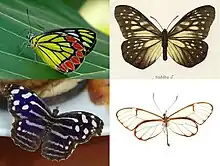| Papilionoidea | |
|---|---|
 | |
| Top left: Delias eucharis Top right: Calinaga buddha | |
| Scientific classification | |
| Domain: | Eukaryota |
| Kingdom: | Animalia |
| Phylum: | Arthropoda |
| Class: | Insecta |
| Order: | Lepidoptera |
| Infraorder: | Heteroneura |
| Clade: | Eulepidoptera |
| Clade: | Ditrysia |
| Clade: | Apoditrysia |
| Clade: | Obtectomera |
| Superfamily: | Papilionoidea Latreille, 1802 |
| Families | |

The superfamily Papilionoidea (from the genus Papilio, meaning "butterfly") contains all the butterflies except for the moth-like Hedyloidea.
The members of the Papilionoidea may be distinguished by the following combination of characters:
- The body is smaller and less moth-like.
- The wings are larger.
- The antennae are straight and clubbed or hooked as in the skippers.
- The caterpillars do not spin cocoons in which to pupate.
- The pupae are angular rather than rounded.
Recent phylogenetic analyses suggest the traditionally circumscribed Papilionoidea are a paraphyletic group, and that skippers (family Hesperiidae) and Neotropical moth-like butterflies (family Hedylidae) are true butterflies that should be included within the Papilionoidea superfamily to reflect cladistic relationships.[1][2]
Families of Papilionoidea
The six well-supported families of Papilionoidea are:
- Hesperiidae[1] (skippers)
- Swallowtails and birdwings, Papilionidae
- Whites or yellow-whites, Pieridae
- Blues and coppers or gossamer-winged butterflies, Lycaenidae
- Metalmark butterflies, Riodinidae
- Brush-footed butterflies, Nymphalidae which contain the following 13 subfamilies:
- The snout butterflies or Libytheinae (formerly the family Libytheidae)
- The danaids or Danainae (formerly the family Danaidae)
- The Tellervinae
- The glasswings or Ithomiinae
- The Calinaginae
- The morphos and owls or Morphinae (including the owls as tribe Brassolini)
- The browns or Satyrinae (formerly the family Satyridae)
- The Charaxinae (preponas and leaf butterflies)
- The Biblidinae
- The Apaturinae
- The nymphs or Nymphalinae
- The Limenitidinae (especially the adelphas)
- The tropical longwings or Heliconiinae
Of the subfamilies of Nymphalidae, only the Morphinae and Satyrinae are possibly paraphyletic, but these two subfamilies form a strongly supported clade with the Charaxinae as sister group.[3]
The fossil genus Lithopsyche is apparently a Papilionoidea incertae sedis, which has long been mistaken for a geometer moth of the Boarmiini. It is variously placed in the Lycaenidae or Riodinidae. A similar fossil, Lithodryas, is more firmly assigned to the Lycaenidae, but might belong to the Nymphalidae. Riodinella, yet another prehistoric genus, also seems to belong here, but its relationships are quite obscure, indeed. However, these fossils – all found in Eocene deposits dating roughly between 50 and 25 million years ago – suggest the radiation of the Papilionoidea into the present-day families took place during that epoch. Prodryas, from the end of the Eocene, can be quite robustly assigned to the Nymphalidae, and is quite likely a member of the Nymphalini. Oligocene fossils of Papilionoidea are usually assignable to an extant family without problems.
Taken together, these fossils place the origin of the Papilionoidea in the latest Mesozoic or early Paleogene, while the extant families emerged around the early Eocene onwards.
References
- 1 2 Heikkilä, M.; Kaila, L.; Mutanen, M.; Peña, C.; Wahlberg, N. (2012). "Cretaceous origin and repeated tertiary diversification of the redefined butterflies". Proceedings of the Royal Society B: Biological Sciences. 279 (1731): 1093–1099. doi:10.1098/rspb.2011.1430. PMC 3267136. PMID 21920981.
- ↑ Kawahara, A. Y.; Breinholt, J. W. (2014). "Phylogenomics provides strong evidence for relationships of butterflies and moths". Proceedings of the Royal Society B: Biological Sciences. 281 (1788): 20140970. doi:10.1098/rspb.2014.0970. PMC 4083801. PMID 24966318.
- ↑ Gerardo Lamas (2008) Systematics of butterflies (Lepidoptera: Hesperioidea and Papilionoidea) in the world: current state and future perspectives (in Spanish). In: Jorge Llorente-Bousquets and Analía Lanteri (eds.) Contribuiciones taxonómicas en ordens de insectos hiperdiversos. Mexico City: UNAM. Pp. 57-70.